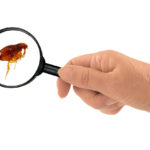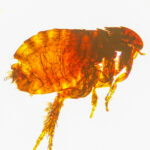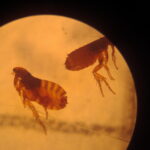How Can We Help?
How to identify a flea infestation?
Spotting a flea infestation can be difficult, but knowing what to look for can help you tackle it quickly. Fleas are tiny, dark brown bugs about 1/8 of an inch long that can jump far. One of the first signs of fleas is your pet's behavior. If  your dog or cat is scratching a lot, grooming nonstop, or seems restless, it might be from flea bites. Take a closer look, and you might see small red bumps or scabs on your pet's skin, especially around the neck, tail, groin, and belly. Fleas love warm, hidden spots on the body, so these are the go-to places to check. Also, have a peek at your pet's bedding and favorite chilling spots for signs of fleas. Flea faeces, which looks like tiny black specks, is actually flea poop. To confirm it's flea dirt put the specks on a wet paper towel; if they turn reddish-brown, it's digested blood and a sure sign of fleas. You might also spot adult fleas crawling or jumping on your pet or around the house. In bad infestations, fleas can show up on carpets, furniture, and even on people. Another hint is unexplained bites on your body, especially around the ankles and lower legs, which are usually itchy and come in clusters or lines. Checking your home thoroughly can reveal signs of flea activity. Use a fine-toothed comb on your pet, and look for fleas or flea dirt in the fur. Frequent vacuuming, especially in areas where your pet hangs out a lot, can help spot and control a flea issue. If you think you have a flea problem, act fast. Fleas multiply quickly, and a small issue can become a big one.
your dog or cat is scratching a lot, grooming nonstop, or seems restless, it might be from flea bites. Take a closer look, and you might see small red bumps or scabs on your pet's skin, especially around the neck, tail, groin, and belly. Fleas love warm, hidden spots on the body, so these are the go-to places to check. Also, have a peek at your pet's bedding and favorite chilling spots for signs of fleas. Flea faeces, which looks like tiny black specks, is actually flea poop. To confirm it's flea dirt put the specks on a wet paper towel; if they turn reddish-brown, it's digested blood and a sure sign of fleas. You might also spot adult fleas crawling or jumping on your pet or around the house. In bad infestations, fleas can show up on carpets, furniture, and even on people. Another hint is unexplained bites on your body, especially around the ankles and lower legs, which are usually itchy and come in clusters or lines. Checking your home thoroughly can reveal signs of flea activity. Use a fine-toothed comb on your pet, and look for fleas or flea dirt in the fur. Frequent vacuuming, especially in areas where your pet hangs out a lot, can help spot and control a flea issue. If you think you have a flea problem, act fast. Fleas multiply quickly, and a small issue can become a big one.
What are the dangers of a flea infestation?
A flea infestation can be pretty dangerous for both pets and humans. For pets, fleas are more than just annoying; they can cause serious health problems. Flea bites lead to itching and scratching, which can lead to hair loss, infections of the skin, and allergic reactions. One common issue is flea allergy dermatitis (FAD), where pets react to flea saliva, causing severe itching and red, inflamed skin. Plus, fleas can carry tapeworms. If a pet swallows a flea that is infected while grooming, it can end up with these parasites, leading to weight loss, irritation, and digestive troubles.
For humans, flea bites cause itchy, red welts, often in clusters or lines around the ankles and legs. Some people might have allergic reactions to flea bites, resulting in severe itching, swelling, and secondary infections from scratching. More worryingly, fleas can transmit serious diseases like murine typhus and the plague, though these are rare in many parts of the world today. The stress of dealing with constant bites and fleas can also cause significant anxiety.
Fleas breed quickly; a single flea can lay hundreds of eggs in its lifetime, leading to a rapidly growing infestation if
What are the most common ways fleas use to gain access to homes?
Fleas can get into homes through various common ways, often catching a ride on pets or humans. The most common route is via pets, especially dogs and cats, who pick up fleas while outside in places like parks, yards, or during walks. Once on a pet, fleas can quickly spread throughout the house, infesting carpets, furniture, and bedding. Wild animals like rodents or squirrels can also bring fleas into your yard and garden. If these animals nest or seek shelter in attics, basements, or crawl spaces, they can spread fleas indoors. Humans can accidentally bring fleas into their homes, too. Fleas can latch onto clothing or shoes when people walk through infested areas, especially places with tall grass or vegetation. Plus, second-hand furniture, rugs, or clothing can be a hidden source of fleas if previously infested items are brought in without proper inspection and cleaning. Even visitors' pets can introduce fleas if they are already carrying them. Once fleas are inside, they multiply quickly, laying eggs in various nooks and crannies, making them hard to get rid of. Flea eggs can fall off pets and become embedded in carpets, upholstery, and pet bedding, where they hatch and continue the infestation cycle. It's also important to note that fleas can survive for several weeks without a host, allowing them to stay hidden and dormant in homes until they find someone to feed on. To keep fleas out, it's crucial to regularly treat pets with flea preventatives, maintain a clean living space, thoroughly inspect second-hand items, and take steps to keep wild animals from entering your property.
How to treat a flea infestation?
Getting rid of a flea infestation takes a few steps to make sure they're gone for good. Start by treating all your pets with vet-recommended flea treatments like topical solutions, oral meds, or flea collars. At the same time, give your home a thorough cleaning—vacuum carpets, rugs, and upholstery to pick up fleas, eggs, and larvae. Wash pet bedding, toys, and linens in hot water and dry them on high heat. You might also want to use flea sprays or foggers designed for indoor use, focusing on areas where your pets hang out the most. Don't forget to treat outdoor areas,
If you suspect a flea infestation, the best solution is to consider professional pest control from us here at Youngs Pest Control; we offer full-service flea treatments, from inspecting your home to applying professional-grade solutions and providing ongoing support to keep your home flea-free.
